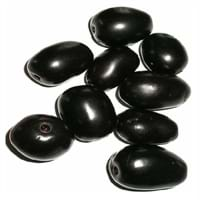Health Benefits
Cancer prevention, Cures gastro-intestinal troubles, Heart care, Muscle pain relief, Prevents blindness from diabetes
Cancer prevention, Heart care, Increase in haemoglobin, Regulates Blood Sugar, Ulcer prevention
General Benefits
Boosts immune system, Digestive aid, Fights against infections, Helps in weight loss, Maintains healthy cholesterol level, Strengthens bones
Boosts immune system, Digestive aid, Fights against infections, Strengthens bones
Skin Benefits
Anti-aging benefits, Skin rejuvenation
Brightens and lightens complexion, Skin cleansing, Skin rejuvenation, Treatment of acne, Treatment of dark spots
Hair Benefits
Promotes longer and healthier hair, Protects hair
Promotes longer and healthier hair, Protects hair
Allergy Symptoms
Coughing, Diarrhea, Headaches, Hives, Itching, Labored Breathing, Nausea, Runny nose, Swelling of mouth, tongue or lips, Vomiting, Watery eyes
Abdominal pains, NA
Side Effects
May cause abdominal pain, Diarrhoea, Mouth irritation, Throat irritation, Weight gain
Decrease in blood sugar levels, Allergic reaction, Throat irritation, Throat swelling, Possibly unsafe during pregnancy
Best Time to Eat
As a snack in the late afternoon, Don't consume at night and before bed, Eat the fresh ones, avoid mixing with any other foods, don't eat after meal., Morning time (before lunch), Strictly avoid empty stomach
As a snack in the late afternoon, Don't consume at night and before bed, Eat the fresh ones, avoid mixing with any other foods, don't eat after meal., Morning time (before lunch), Strictly avoid empty stomach
Vitamin B5 (Pantothenic Acid)
Not Available
Vitamin B9 (Folic acid)
Not Available
Vitamin C (Ascorbic Acid)
Vitamin E (Tocopherole)
Not Available
Vitamin K (Phyllochinone)
Not Available
Lutein+Zeaxanthin
Not Available
Phytosterol
Not Available
Calories in Fresh Fruit with Peel
Not Available
Calories in Fresh Fruit without Peel
Not Available
Calories in Frozen Form
Not Available
Calories in Dried Form
Not Available
Calories in Canned Form
Not Available
Type
Tree fruit, Tropical
Tree fruit, Tropical
Season
Spring, Summer
Monsoon, Summer
Varieties
Emperor fruit, Mauritiu, Sweet Heart, Brewster, Haak Yip and Bengal
Ram Jarnun and Paras
Color
Bright red, Pink red
Black, Magenta, Purple
Inside Color
Greyish-white
Purple
Taste
Crunchy, Juicy, Sweet
Astringent, Sweet
Origin
China, Indonesia, Philippines, Vietnam
Bangladesh, India, Indonesia, Malaysia, Nepal, Pakistan, Philippines, Sri Lanka
Soil Type
Alluvial, Loam, Well-drained
Loam, Sandy loam, Well-drained
Climatic Conditions
Absence of strong wind, Cold, Dry, Without frosts
Humid, Rainfall
Facts about
- The seed of Lychee fruit is toxic & can adversely affect the digestive system.
- This fruit gives a smoky flavor when eaten dried.
- This fruit is a symbol of love and romance in China.
- Wood of jambul tree is water-resistant wood & is used in railroads and to implement engines in the well.
- In Indian mythology, it is said that Jambul fruit was revered by Buddha.
- Jambul has a huge importance in Ayurveda.
Other Countries
Australia, India, South Africa, Thailand, United States of America
Bangladesh, Indonesia, Malaysia, Nepal, Pakistan, Philippines, Sri Lanka
Top Importer
Hong Kong
Not Available
Botanical Name
Litchi chinensis
Syzygium cumini
Synonym
Nephelium litchi
Eugenia cumini
Subkingdom
Tracheobionta
Tracheobionta
Division
Magnoliophyta
Magnoliophyta
Class
Magnoliopsida
Magnoliopsida
Order
Sapindales
Myrtales
Family
Sapindaceae
Myrtaceae
Species
L. chinensis
S. cumini
Generic Group
Soapberry
Not Available
Difference Between Lychee and Jambul
We might think that Lychee and Jambul are similar with respect to nutritional value and health benefits. But the nutrient content of both fruits is different. Lychee and Jambul Facts such as their taste, shape, color, and size are also distinct. The difference between Lychee and Jambul is explained here.
The amount of calories in 100 gm of fresh Lychee and Jambul with peel is Not Available and 60.00 kcal and the amount of calories without peel is 66.00 kcal and Not Available respectively. Thus, Lychee and Jambul belong to Low Calorie Fruits and Low Calorie Fruits category.These fruits might or might not differ with respect to their scientific classification. The order of Lychee and Jambul is Sapindales and Myrtales respectively. Lychee belongs to Sapindaceae family and Jambul belongs to Myrtaceae family. Lychee belongs to Litchi genus of L. chinensis species and Jambul belongs to Syzygium genus of S. cumini species. Beings plants, both fruits belong to Plantae Kingdom.









